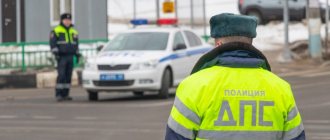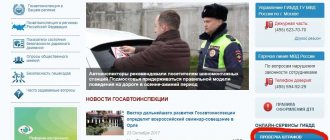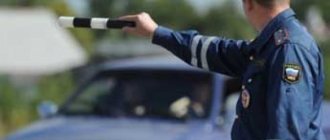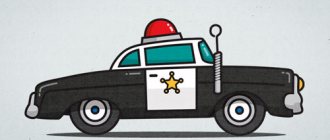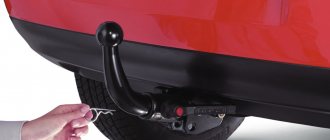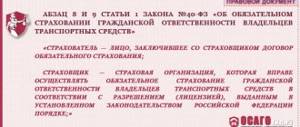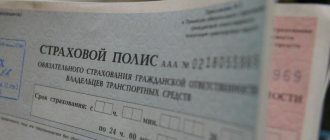electronic insurance policy
Electronic sales should solve the problem of availability of compulsory motor insurance in problem regions.
Electronic sales should solve the problem of availability of compulsory motor insurance in problem regions.
Let me remind you that when purchasing an electronic policy, you can choose either a regular printed form (they will send it to you by mail or offer to pick it up at the office) or an electronic version. In the latter case, you will be sent an MTPL policy number by email (like an electronic ticket for a plane or train).
Review of changes to traffic rules from April 4, 2021, introduction of a new traffic police fine
"Road Train"
- in the form of three orange lights located horizontally on the roof of the cab with gaps between them from 150 to 300 mm - on trucks and wheeled tractors (class 1.4 tons and above) with trailers, as well as on articulated buses and trolleybuses;
"Spikes"
- in the form of an equilateral triangle of white color with the top up with a red border, in which the letter “W” is inscribed in black (
the side of the triangle is at least 200 mm, the width of the border is 1/10 of the side ) - behind motor vehicles with studded tires;
"Transportation of children"- in the form of a yellow square with a red border (border width - 1/10 of the side), with a black image of the symbol of the road sign 1.23 (the side of the square of the identification sign located in front of the vehicle must be at least 250 mm, at the rear - 400 mm) ;
"Deaf Driver"
- in the form of a yellow circle with a diameter of 160 mm with three black circles with a diameter of 40 mm inside, located at the corners of an imaginary equilateral triangle, the apex of which faces downwards, - in front and behind motor vehicles driven by deaf-mute or deaf drivers;
"Training Vehicle"
- in the form of a white equilateral triangle with the apex up with a red border, in which the letter “U” is inscribed in black (a side of at least 200 mm, border width - 1/10 of a side), - in front and behind motor vehicles used for training driving (installation of a double-sided sign on the roof of a car is allowed);
"Speed Limit"
- in the form of a reduced color image of road sign 3.24 indicating the permitted speed (sign diameter - at least 160 mm, border width - 1/10 of the diameter) - on the rear left side of the body of motor vehicles carrying out organized transportation of groups of children transporting large items, heavy and dangerous goods, as well as in cases where the maximum speed of the vehicle according to its technical characteristics is lower than that specified in paragraphs 10.3 and 10.4 of the Road Traffic Rules of the Russian Federation;
"Dangerous Cargo"
:
- when carrying out international transportation of dangerous goods - in the form of a rectangle measuring 400 x 300 mm, having an orange reflective coating with a black border no more than 15 mm wide - in front and behind vehicles, on the sides of tanks, as well as in prescribed cases - on sides of vehicles and containers;
- when carrying out other transportation of dangerous goods - in the form of a rectangle measuring 690 x 300 mm, the right part of which measuring 400 x 300 mm is painted orange, and the left part is painted white with a black border 15 mm wide - in front and behind the vehicles.
Symbols characterizing the dangerous properties of the transported cargo are applied to the identification mark;
"Large cargo"
— in the form of a shield measuring 400 x 400 mm with diagonally applied red and white alternating stripes 50 mm wide with a reflective surface;
"Slow Moving Vehicle"
- in the form of an equilateral triangle with a red fluorescent coating and a yellow or red reflective border (triangle side length from 350 to 365 mm, border width from 45 to 48 mm) - behind motor vehicles for which the manufacturer has set a maximum speed no more than 30 km/h;
"Long vehicle"
- in the form of a rectangle measuring at least 1200 x 200 mm, yellow with a red border (40 mm wide), having a reflective surface, - behind vehicles whose length with or without load is more than 20 m, and road trains with two or more trailers . If it is impossible to place a sign of the specified size, it is allowed to install two identical signs measuring at least 600 x 200 mm symmetrically to the axis of the vehicle.
"Beginner Driver"
- in the form of a yellow square (side 150 mm) with an image of a black exclamation mark 110 mm high - behind motor vehicles (except for tractors, self-propelled vehicles, motorcycles and mopeds) driven by drivers who have less than 2 licenses to drive these vehicles years.
era-glonass
While new cars will be required to be equipped with the ERA-GLONASS system, this is not yet an available option for those in service.
While new cars will be required to be equipped with the ERA-GLONASS system, this is not yet an available option for those in service.
There is, perhaps, no doubt about the usefulness of the system itself. After all, in the event of an emergency on the road, the driver or passengers have the opportunity to contact the operator of the contact center of the ERA-GLONASS system via wireless communication channels and request assistance. In this case, geolocation data is automatically transmitted. But despite the fact that huge amounts of money have been invested in this system, I would not talk about complete readiness. For example, if you want to install the ERA-GLONASS device on your car yourself, you simply will not be able to connect it. As NP GLONASS (the system operator) explained to me, connecting private owners is virtually impossible for now.
"Ambushes" of the traffic police
If in the previously existing regulations, checks of the driver and his documents were carried out only at stationary posts, then from October 2021 the patrol crew has the right to stop any car on the road.
By order of the leadership of a particular unit, a route map is created indicating the location of each patrol car, and if desired, the driver will be able to verify this himself if he asks to show it for viewing.
When patrolling on the road, a number of conditions specified in the new regulations must be met:
- No one has canceled the basic rule - the driver must clearly see the patrol car of traffic inspectors . True, it may be without characteristic features - stripes and a warning device on the roof, which will create certain difficulties for the driver to recognize it at a long distance.
- The patrol car is camouflaged solely by using the natural landscape - behind a hill, a sharp turn, or road infrastructure.
- On board the patrol car there must be certified video and photographic devices for recording committed offenses.
- Also, road control is carried out exclusively on sections of roads with a high accident rate and cannot be carried out at the request of the inspector himself. Each patrol crew is assigned a specific place where they are required to perform their official duties.
So, since the new regulations came into force, traffic police ambushes have returned to our roads.
camera for photographing violations
Cameras should be installed on sections of roads with poor visibility, near schools, at intersections, as well as in places with a high concentration of violators, and in those areas where more than three accidents with casualties occurred during the year.
Cameras should be installed on sections of roads with poor visibility, near schools, at intersections, as well as in places with a high concentration of violators, and in those areas where more than three accidents with casualties occurred during the year.
Let me remind you that the Agency for Technical Regulation and Metrology has approved new GOSTs, according to which the speed measurement range should be 20–250 km/h, while the probability of license plate recognition, regardless of the time of day and weather, should be at least 90%. Photographs of the offender’s car must allow one to identify the distinctive features of the vehicle.
Be ready! Changes in traffic rules 2017 and more
Changes in traffic rules from April 4, 2021
It is worth taking a closer look at what changes have occurred in traffic rules since April 4. The clauses introducing several restrictions for motorists without long driving experience have been added.
- Before the traffic rules change, the maximum speed for bikers on all roads was no higher than 90 km/h. After April 4, it became possible to travel at a speed of 110 km/h on highways and no more than 90 km/h on other types of road surfaces.
- A new clause has been added to the traffic rules regarding vehicle towing. The vehicle being towed must be driven by experienced drivers with a license of any category with at least 2 years of experience. This does not apply to trailers, but only applies to mechanical vehicles.
- A new paragraph has been added affecting the rules for transporting people on motorcycles and mopeds. Driving 2-wheeled vehicles with passengers should only be carried out by experienced motorcyclists with at least 2 years of experience. Bikers with a license of any category, but with at least 2 years of registered driving experience, are allowed to drive a moped with a passenger.
- The changes affected the paragraph describing the “Beginner Driver” sign. A moped has been added to the definition of “except”, which now stands on the same level as other vehicles.
- A new clause introducing a fine for the lack of specific identification marks installed on a car or other vehicle. For example, signs: “Beginner Driver”, “Dangerous Goods”, “Deaf Driver”, etc.
Changes in traffic rules for beginners and more
A novice driver (with less than two years of driving experience) can no longer tow other motor vehicles. Violation is punishable by a warning or a fine of 500 rubles.
In addition, a ban has been introduced on the operation of vehicles if they do not have identification marks, which must be installed in accordance with the Basic Provisions for the admission of vehicles to operation and the duties of officials to ensure road safety. These are signs such as “Beginner Driver”, “Spikes”, “Transportation of Children”, “Deaf Driver” and others.
Driving a vehicle that does not have the specified identification marks will result in a warning or a fine of 500 rubles.
“The innovations are aimed at reducing the level of accidents involving novice drivers, as well as the severity of the consequences of possible accidents with their participation,” Andrey Gladkikh emphasized.
Changes for motorcyclists
Government Decree No. 333 dated March 24, 2017 “On amendments to Resolution of the Council of Ministers - Government of the Russian Federation dated October 23, 1993 No. 1090” came into force. It provides for a number of changes to the traffic rules that affect motorcyclists.
As Andrei Gladkikh, inspector for special assignments of the department for organizing the road patrol service and execution of administrative legislation of the State Traffic Safety Inspectorate of the Ministry of Internal Affairs of Russia in the region, said, the maximum speed of motorcycles outside populated areas on highways can now be 110 km/h. On other roads it is allowed to drive at a speed of no more than 90 km/h. Previously, motorcycles were allowed to travel outside populated areas on all roads at a speed of no more than 90 km/h.
Also, novice drivers of mopeds and motorcycles are prohibited from transporting passengers on the motorized vehicles they drive until they have achieved two years of experience. The fine for violating the rules for transporting passengers will be 500 rubles.
Simplification of the procedure for registering transport incidents
The procedure for registering road accidents has also undergone significant changes. Now, according to the algorithm developed by the authorities, drivers will be able to do without the participation of police at the scene of an accident. The exception will be accidents that result in death or in which there are serious injuries. In other cases, vehicle owners themselves will be able to record the consequences of the accident; in some cases, documents may not be drawn up at all.
For a simplified procedure for registering an accident, drivers will receive special insurance notification forms - Europrotocols. If both drivers are of the same opinion about the causes of the traffic accident and adequately assess the consequences, then all they have to do is fill out the appropriate protocol.
Drivers who agree on the spot or have no complaints against each other may not fill out any paperwork at all, but simply go in different directions. A traffic police officer can also give you recommendations on registration over the phone. He will listen to all the circumstances of the accident and advise whether it is possible to draw up the documents yourself or whether it is necessary to wait for the police.
Currently, all the innovations of the traffic rules for 2021 are already ready. There is controversy over only one issue, which concerns the term “dangerous driving”, or rather the punishment for such an offense.
“Dangerous driving” is understood as a situation where the driver of a vehicle or other road user creates a situation on the road that is considered dangerous to others. To reduce the occurrence of such situations on the roads, it is necessary to take a number of stricter measures. This will reduce the number of people who want to have a blast on public roads without thinking about the consequences for passengers and pedestrians.
All innovations in traffic rules that come into force in 2021 should improve the situation on the roads, because recently it has only become worse.
